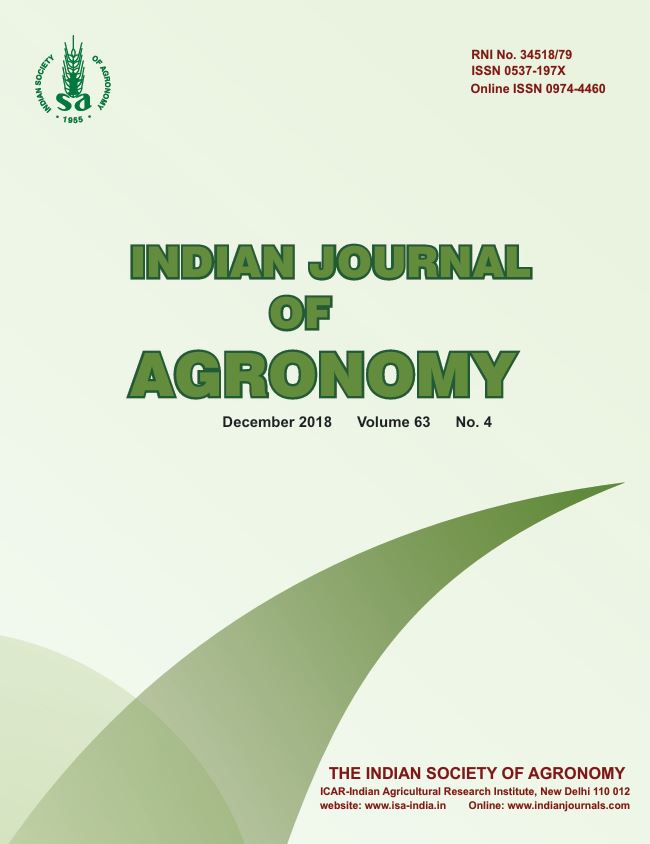Effect of foliar supplementation of N, P and K on nutrient dynamics and productivity of pearl millet (Pennisetum glaucum)
DOI:
https://doi.org/10.59797/ija.v63i4.5696Keywords:
Economics, Foliar supplementation, Nutrient uptake, Pearl millet, Phosphorus, Potassium, YieldAbstract
A field experiment was conducted at Bikaner, Rajasthan during rainy (kharif) season of 2016 to study the effect of foliar supplementation of N, P and K on nutrient content, uptake and productivity of pearl millet [Pennisetum glaucum (L.) R. Br. emend Stuntz]. The experiment was laid out in randomized block design with 3 replications. The treatments comprised 14 combinations of N, P and K applied through basal application, foliar application and top-dressing. The results revealed that, application of N, P and K through foliar supplementation significantly influenced the nutrient content and uptake in pearl millet. Application of 75% RDF of N (50% basal + 25% top-dressing at 25 DAS) : P : K + 1.5% spray of NPK (18:18:18) at 35 DAS resulted in maximum crude protein content (11.58%), total N uptake (70.7 kg/ha), total P uptake (13.1 kg/ha), total K uptake (74.0 kg/ha), ear-head length (32.4 cm), grain weight per ear-head (23.3 g), grain yield (2.13 t/ha), biological yield (6.88 t/ha) and B:C ratio (2.16) under hot arid conditions of western Rajasthan.
References
AOAC. 1960. Official Method of Analysis, 18 edn. Association of Official Agricultural Chemists, Washington, DC.
Ansari, M.A., Rana, K.S., Rana, D.S. and Kumar, P. 2011. Effect of nutrient management and anti-transpirant on rainfed sole and intercropped pearlmillet (Pennisetum glaucum) and pigeonpea (Cajanus cajan). Indian Journal of Agronomy 56(3): 209–216.
Bamboriya, S.D., Bana, R.S., Pooniya, V., Rana, K.S. and Singh Y.V. 2017. Planting density and nitrogen management effects on productivity, quality and water-use efficiency of rainfed pearlmillet (Pennisetum glaucum) under conservation agriculture. Indian Journal of Agronomy 62(3): 363–366.
Bana, R.S., Gautam, R.C. and Rana, K.S. 2012. Effect of different organic sources on productivity and quality of pearlmillet and their residual effect on wheat. Annals of Agricultural Research 33(3): 126–130.
Choudhary, G.L., Rana, K.S., Rana, D.S., Bana, R.S., Prajapat, K. and Choudhary, M. 2016. Moisture management and zinc fortification impacts on economics, quality and nutrient uptake of pearlmillet (Pennisetum glaucum L.) under rainfed conditions. Indian Journal of Agricultural Sciences 86(1): 71–77.
Choudhary, R.S. and Gautam, R.C. 2007. Effect of nutrient-management practices on growth and yield of pearl millet. Indian Journal of Agronomy 52(1): 64–66.
Fisher, R.A. 1950. Statistical Methods for Research Workers. Oliver and Boyd. Edinburg, London, U.K.
GoI. 2015–16. Economic Survey, Government of India, Ministry of Finance and Company Affairs, Economic Division, New Delhi.
Rana, K.S., Kumar, D. and Bana, R.S. 2012. Agronomic research on pearlmillet (Pennisetum glaucum). Indian Journal of Agronomy 57(3rd IAC: Special issue): 45–51.
Rathore, V.S., Singh, P. and Gautam, R.C. 2006. Productivity and water use efficiency of rainfed pearl millet (Pennisetum glaucum L.) as influenced by planting patterns and integrated nutrient management. Indian Journal of Agronomy 51(1): 46–48.






